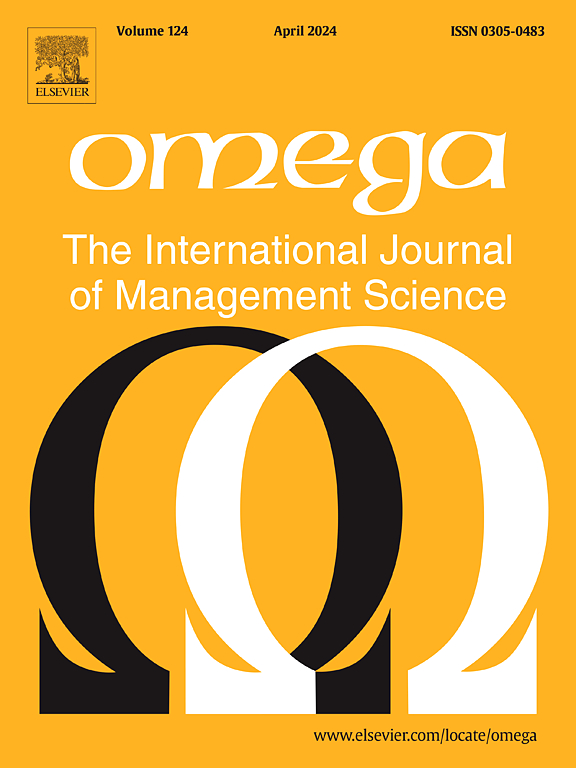Managing equitable contagious disease testing: A mathematical model for resource optimization
IF 7.2
2区 管理学
Q1 MANAGEMENT
Omega-international Journal of Management Science
Pub Date : 2025-02-25
DOI:10.1016/j.omega.2025.103305
引用次数: 0
Abstract
All nations in the world were under tremendous economic and logistical strain as a result of the advent of COVID-19. Early in the epidemic, getting COVID-19 diagnostic tests was a significant difficulty. Furthermore, logistical challenges arose from the restricted transportation infrastructure and disruptions in international supply chains in the distribution of these testing kits. In the face of such obstacles, it is critical to give patients' needs top priority in order to provide fair access to testing. In order to manage contagious disease testing, this work proposes a bi-objective and multi-period mathematical model with an emphasis on mobile tester route plans and testing resource allocation. In order to optimize patient scores and reduce the likelihood of patients going untreated, the suggested team orienteering model takes into account issues like resource limitations, geographic clustering, and testing capacity limitations. To this aim, we present a comparison between quarantine and non-quarantine scenarios, introduce an equitable categorization based on disease backgrounds into “standard” and “risky” groups, and cluster geographical locations according to average age and contact rate. We use a Multi-Objective Variable Neighborhood Search (MOVNS) and a Non-Dominated Sorting Genetic Algorithm II (NSGA-II) to solve our problem. Due to the superiority of MOVNS, it is applied to a case study in Vienna, Austria. The results demonstrate that, over the course of several weeks, the average number of unserved risky patients in the prioritizing scenario is consistently lower than the usual number of patients. In the absence of prioritization, the average number of high-risk patients who remain untreated rises sharply and exceeds that of regular patients, though. Furthermore, it is clear that waiting times are greatly impacted by demand volume when comparing scenarios with and without quarantine.
管理公平的传染病检测:资源优化的数学模型
由于新冠肺炎的到来,世界各国都面临着巨大的经济和后勤压力。在疫情早期,获得COVID-19诊断测试是一个很大的困难。此外,由于运输基础设施有限以及国际供应链在分发这些检测包方面受到干扰,后勤方面也面临挑战。面对这些障碍,至关重要的是要优先考虑患者的需求,以便提供公平获得检测的机会。为了管理传染病检测,本文提出了一个双目标、多周期的数学模型,重点关注移动测试人员的路线规划和测试资源分配。为了优化患者得分并减少患者不接受治疗的可能性,建议的团队定向模型考虑了资源限制、地理聚类和测试能力限制等问题。为此,我们对隔离和非隔离情景进行了比较,根据疾病背景将其公平地分为“标准”组和“危险”组,并根据平均年龄和接触率对地理位置进行了聚类。我们使用多目标变量邻域搜索(MOVNS)和非支配排序遗传算法II (NSGA-II)来解决我们的问题。由于MOVNS的优越性,将其应用于奥地利维也纳的一个案例研究。结果表明,在几个星期的过程中,优先方案中未得到服务的风险患者的平均数量始终低于通常的患者数量。在没有优先排序的情况下,未接受治疗的高危患者的平均人数急剧上升,超过了普通患者的人数。此外,很明显,在比较有隔离和没有隔离的情况时,等待时间受到需求量的极大影响。
本文章由计算机程序翻译,如有差异,请以英文原文为准。
求助全文
约1分钟内获得全文
求助全文
来源期刊

Omega-international Journal of Management Science
管理科学-运筹学与管理科学
CiteScore
13.80
自引率
11.60%
发文量
130
审稿时长
56 days
期刊介绍:
Omega reports on developments in management, including the latest research results and applications. Original contributions and review articles describe the state of the art in specific fields or functions of management, while there are shorter critical assessments of particular management techniques. Other features of the journal are the "Memoranda" section for short communications and "Feedback", a correspondence column. Omega is both stimulating reading and an important source for practising managers, specialists in management services, operational research workers and management scientists, management consultants, academics, students and research personnel throughout the world. The material published is of high quality and relevance, written in a manner which makes it accessible to all of this wide-ranging readership. Preference will be given to papers with implications to the practice of management. Submissions of purely theoretical papers are discouraged. The review of material for publication in the journal reflects this aim.
 求助内容:
求助内容: 应助结果提醒方式:
应助结果提醒方式:


